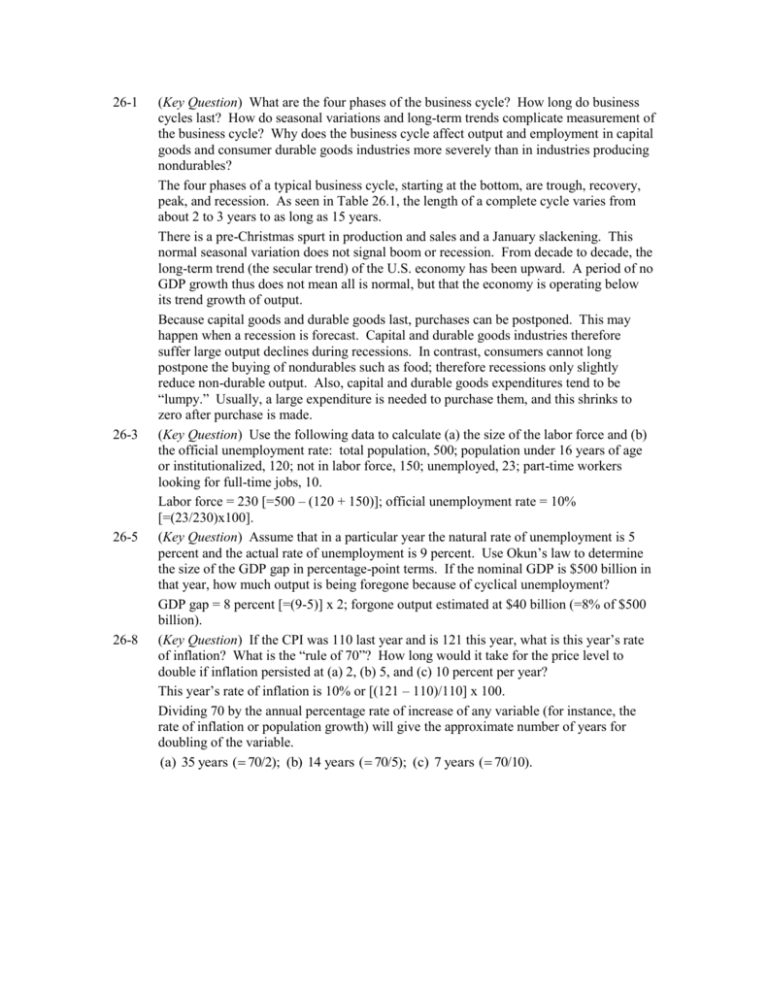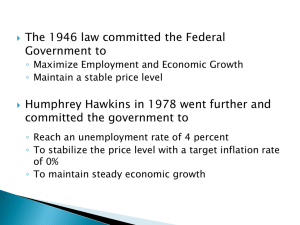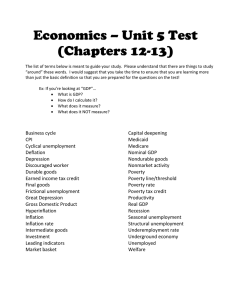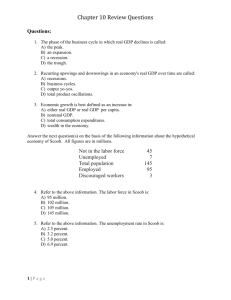Chapter 26 Key Question Solutions
advertisement

26-1 26-3 26-5 26-8 (Key Question) What are the four phases of the business cycle? How long do business cycles last? How do seasonal variations and long-term trends complicate measurement of the business cycle? Why does the business cycle affect output and employment in capital goods and consumer durable goods industries more severely than in industries producing nondurables? The four phases of a typical business cycle, starting at the bottom, are trough, recovery, peak, and recession. As seen in Table 26.1, the length of a complete cycle varies from about 2 to 3 years to as long as 15 years. There is a pre-Christmas spurt in production and sales and a January slackening. This normal seasonal variation does not signal boom or recession. From decade to decade, the long-term trend (the secular trend) of the U.S. economy has been upward. A period of no GDP growth thus does not mean all is normal, but that the economy is operating below its trend growth of output. Because capital goods and durable goods last, purchases can be postponed. This may happen when a recession is forecast. Capital and durable goods industries therefore suffer large output declines during recessions. In contrast, consumers cannot long postpone the buying of nondurables such as food; therefore recessions only slightly reduce non-durable output. Also, capital and durable goods expenditures tend to be “lumpy.” Usually, a large expenditure is needed to purchase them, and this shrinks to zero after purchase is made. (Key Question) Use the following data to calculate (a) the size of the labor force and (b) the official unemployment rate: total population, 500; population under 16 years of age or institutionalized, 120; not in labor force, 150; unemployed, 23; part-time workers looking for full-time jobs, 10. Labor force = 230 [=500 – (120 + 150)]; official unemployment rate = 10% [=(23/230)x100]. (Key Question) Assume that in a particular year the natural rate of unemployment is 5 percent and the actual rate of unemployment is 9 percent. Use Okun’s law to determine the size of the GDP gap in percentage-point terms. If the nominal GDP is $500 billion in that year, how much output is being foregone because of cyclical unemployment? GDP gap = 8 percent [=(9-5)] x 2; forgone output estimated at $40 billion (=8% of $500 billion). (Key Question) If the CPI was 110 last year and is 121 this year, what is this year’s rate of inflation? What is the “rule of 70”? How long would it take for the price level to double if inflation persisted at (a) 2, (b) 5, and (c) 10 percent per year? This year’s rate of inflation is 10% or [(121 – 110)/110] x 100. Dividing 70 by the annual percentage rate of increase of any variable (for instance, the rate of inflation or population growth) will give the approximate number of years for doubling of the variable. (a) 35 years ( 70/2); (b) 14 years ( 70/5); (c) 7 years ( 70/10).











